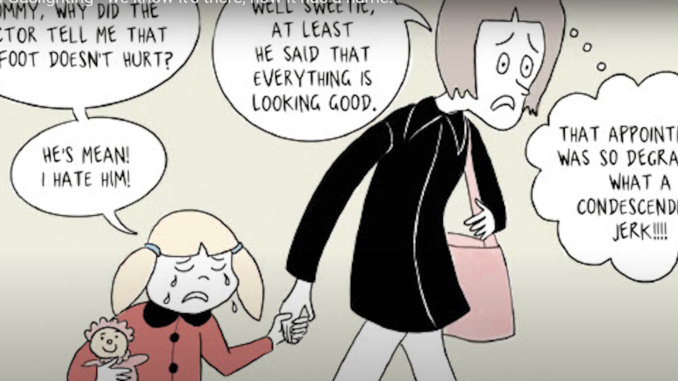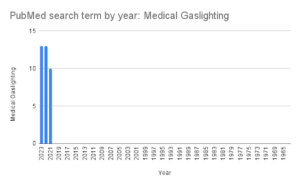
It could be ‘medical-gaslighting’– especially if you are one of these people
Writer: Perry Lupyrypa
Graphic artist Goldberg Nash is using her creative abilities to increase awareness of medical gaslighting. She says it’s when health professionals don’t take patients’ complaints seriously. Her daughter suffers a chronic condition and for 15 years, she says doctors dismissed her conditions.
“Ir happens to patients with chronic pain, Long COVID, women, elderly people and other marginalized groups. Women especially have been mistreated for a long time.”
–Vancouver emergency physician Anthony Fong,
Research shows compared to men, women are diagnosed with cancer 2.5 years later; are more likely to be misdiagnosed with certain conditions like heart disease and autoimmune disorders; and wait longer for a diagnosis.
Toronto associate professor Cathy Sobocan suffered from migraines for decades after first menstruating in her teens. She says her pain often lasted for days. Her doctors simply told her to take a pill and rest.
Studies show the vast majority of migraine sufferers are women. Migraines are chronic crippling pain attacks affecting the entire body for several days. This differs from typical headaches which usually aren’t considered severe and last no longer than a few hours.
For Sobocan, it took years of different doctors and endless visits to find a neurologist, who finally prescribed rizatriptan, a drug that works in the brain to stop migraine headache pain.
Historians report discriminatory behavior towards women traces back to the 5th century BCE and the father of modern medicine, Hippocrates. He believed the womb traveled throughout the female body causing hysteria, prescribing intercourse to “moisten” the womb and improve blood circulation. He also recommended placing strong scents near their vagina or mouth.

Throughout antiquity to the middle ages and the renaissance, misogynist remedies for women’s ailments were reported. They were about the uterus and included things like either having sex or no sex and placing strong scents placed near the afflicted female vagina or mouth. Between 1550 – 1700 the uterus became a source of evil. Hysterical women were witches. The cure? – torture, exorcism or death. In the 1700s when ancient texts became available and were translated. hysteria once again became a physical disease. By Victorian times, hysterical paroxysm was reported to affect up to 75% of females. Doctors curing this female malady with pelvic massage. A treatment so popular, researchers claim the electric vibrator was invented relieve physicians whose arms were sore after several hours of massaging female uteruses.
By the 1920s, Sigmond Freud’s psychological theory of hysteria and assertions of “male hysteria” prevailed. The psychological diagnosis was finally removed in 1980 from the updated Diagnostic and Statistical Manual of Mental Disorders, 3rd ed. Today’s non-gender hysterical symptoms are considered manifestations of dissociative disorders caused by trauma or external influences.
Yet, medical gaslighting is very much with us still and amplified, it seems, by the SARS-CoV-2 Pandemic.
Long COVID affected large swaths of the adult population – about 7.5 % in the U.S. and 12% in Canada.
Using #longCOVID to describe symptoms and #medicalgaslighting to call out shameful behavior of medical professionals, long-haulers galvanized an on-line community seeking treatment, remedy and recognition of their ailments.

At the beginning of 2020 during the first wave of the SARS-CoV-2 Pandemic, cyber sufferers invented the disease #LongCOVID, launching a remote conversation describing symptoms with assertions of being ignored by doctors. By May 2020 print media was reporting on Long COVID. In June 2020 physicians in London England were preparing for an influx of Long COVID sufferers. By September 2020 the term “medical gaslighting” alongside the new disease Long COVID debuted in medical literature.
Timeline Visual Charts Presentation in Aquamarine Black White Simple Style by plupyrypa
In October 2020, the first ever scholarly article describing dismissal or downplaying of gynecological pain and symptoms in women as “medical gaslighting” was published.
When something has a name – it’s easier to have a conversation about it.

The U.S. National Institute of Health’s (NIH) PubMed database lists 2020 as the first reference for “medical gaslighting” There are 41 references in total.
By contrast “irritable bowel syndrome” which occurs in less than 1% of the population, has 129,962 references. The first in 1945.
- In 2021 the NIH allocated $165 million on crohn’s and inflammatory bowel diseases – disorders affecting less than 1% of the population. That’s about six times the $30 million they gave to study female afflictions of endometriosis and uterine fibroid and for female genitalia research. The NIH only mandated the inclusion of women in medical research in 1993. Even so many investigators either ignored

PubMed seasch irritable bowel syndrome or didn’t break out results by sex. Today sex-based biology and medicine is only a specialty and not standard practice in medical research. Women’s birth and death are prioritized. But non-cancerous diseases affecting women’s quality of life are neglected. So, women’s overall health continues to be devalued.
When asked about medical gaslighting, Vancouver family physician Dr. Birinder Narang says “If you are not actively listening, you are perpetuating patient harm and making it worse for patients who may be reluctant in the future to express their concerns.”
Sobocan says “ If your doctor isn’t helping, get a second or a third opinion until you find someone who will listen.” She says be your own advocate and shares these tips:
- keep a record of your symptoms and bring them with you when seeing a doctor for the first time
- take notes during your meeting
- If possible bring a friend or a family member with you
- If you don’t like what you hear – get a second opinion.
[Original size] White Colorful Gradient Modern Professional Timeline Artificial Intelligence Infographic by plupyrypa


Be the first to comment